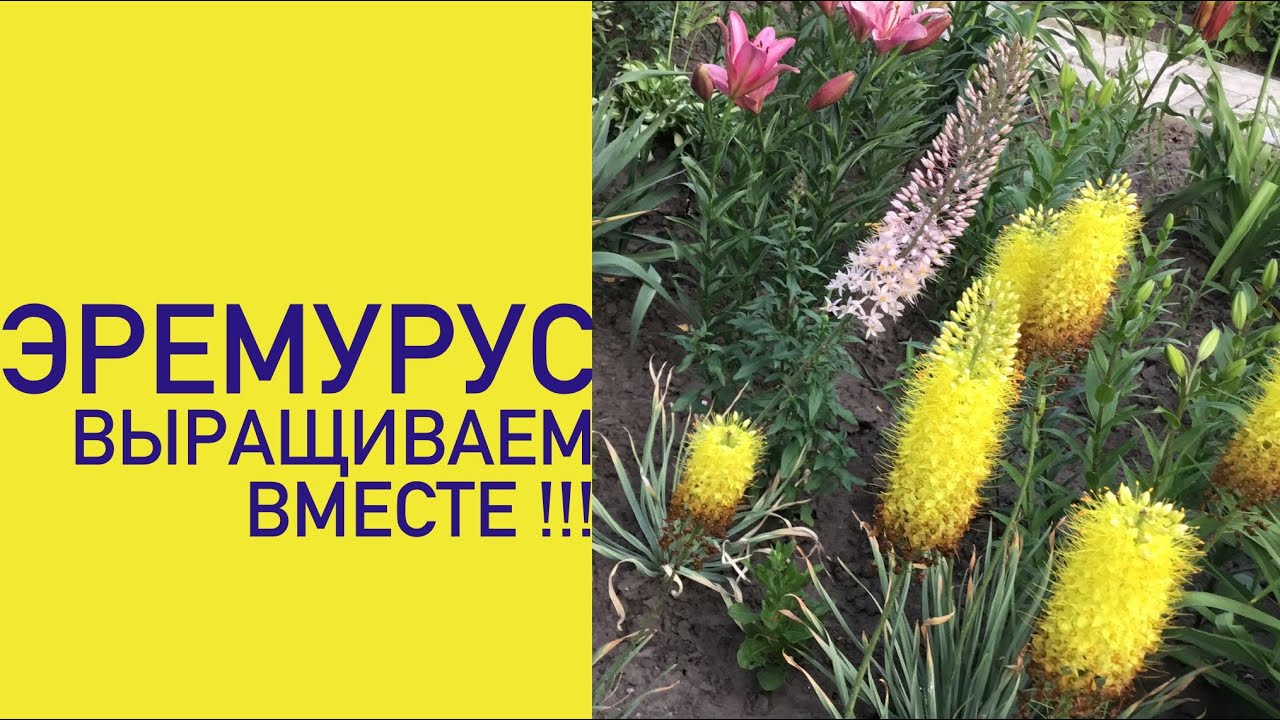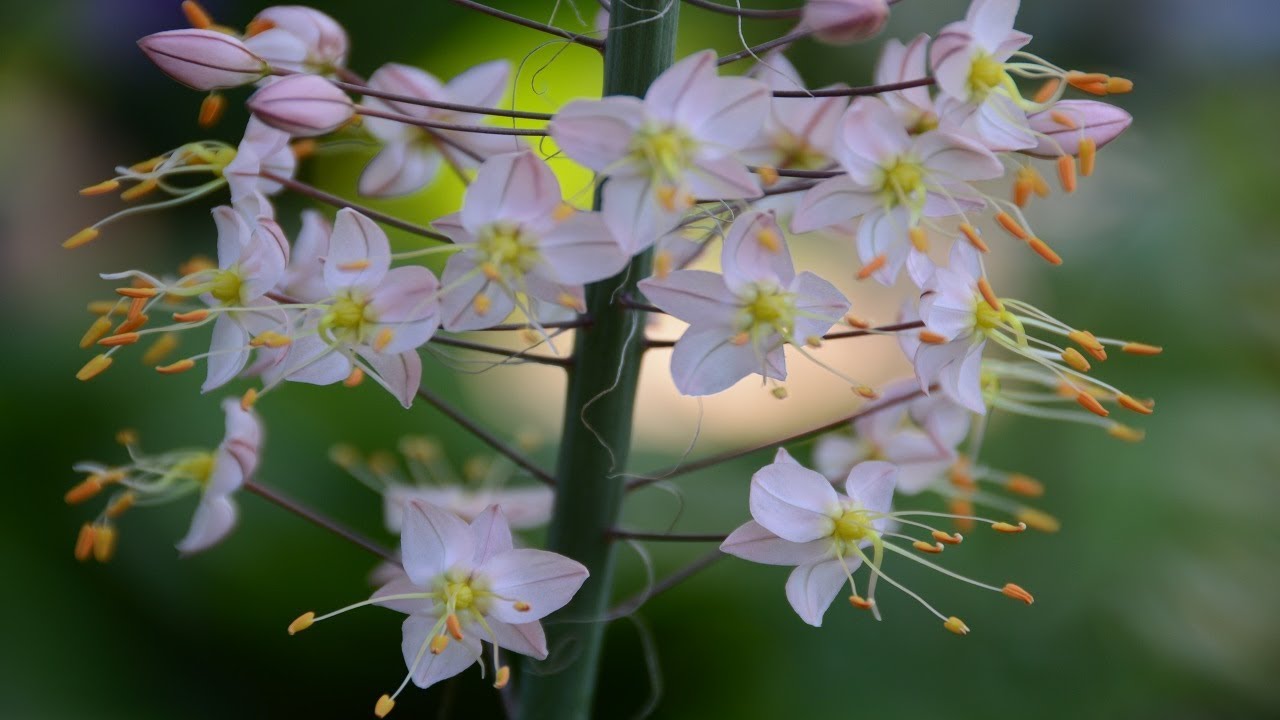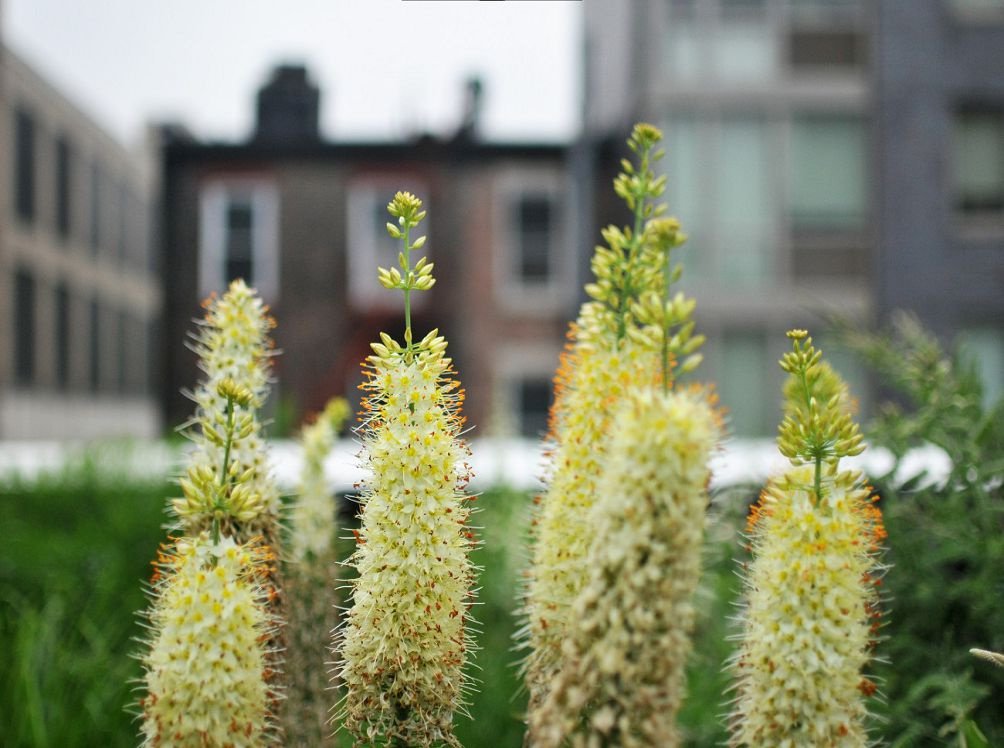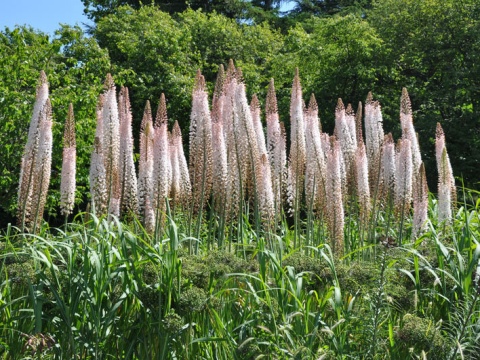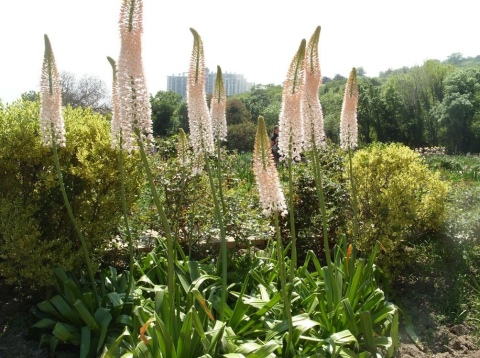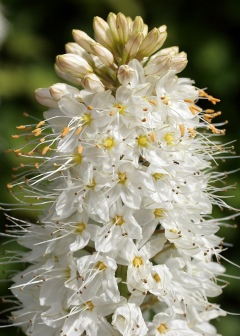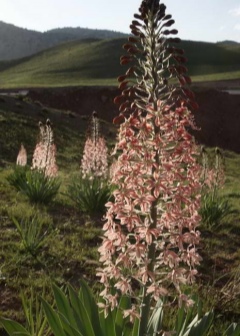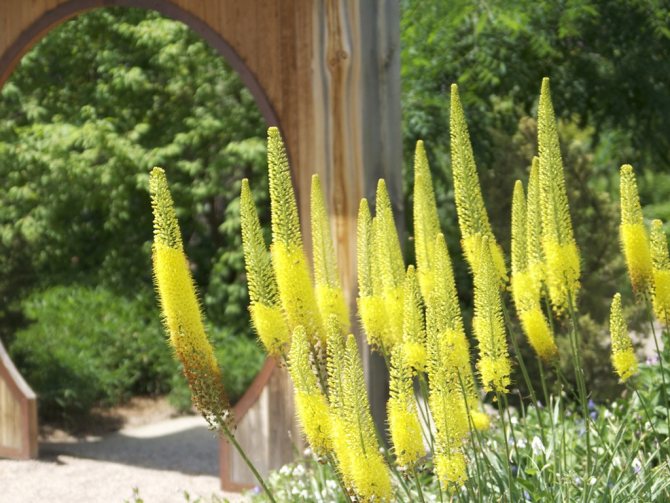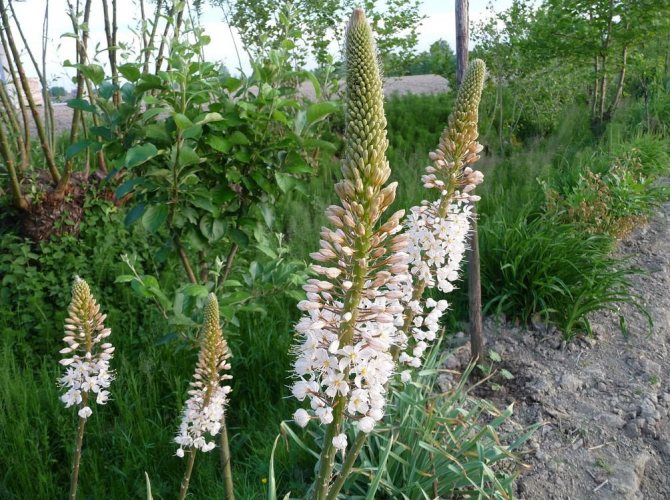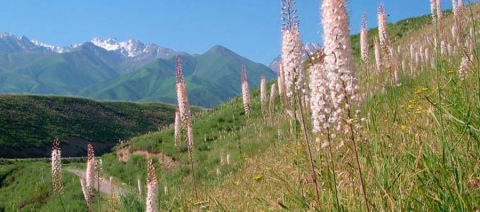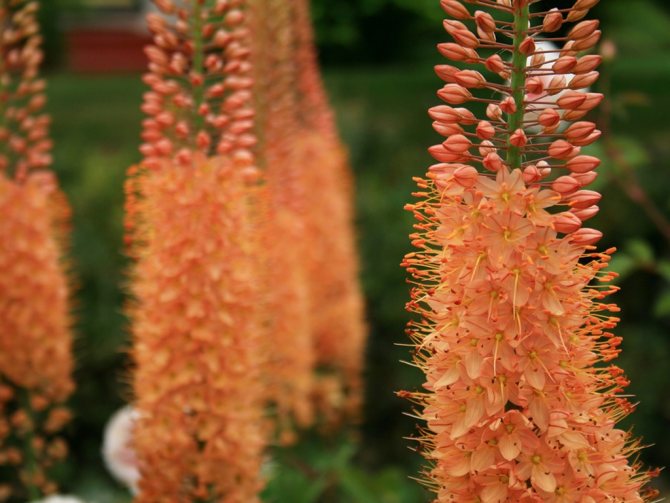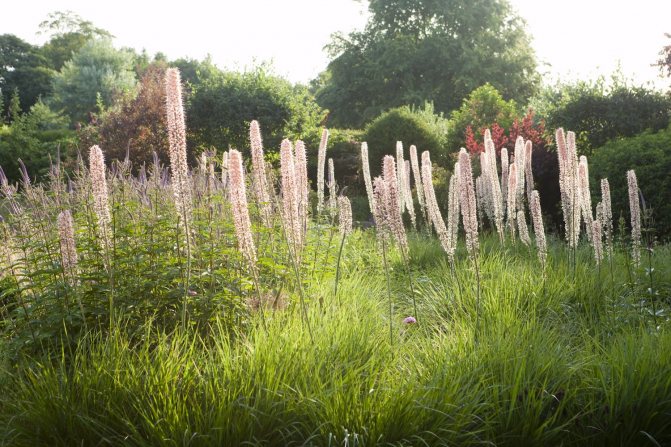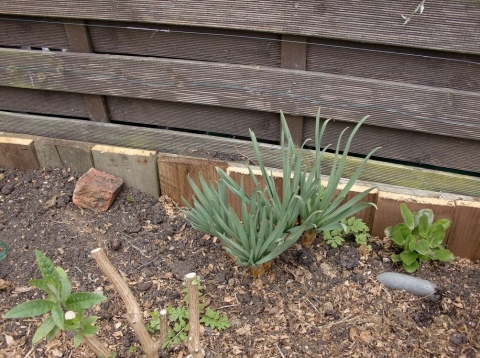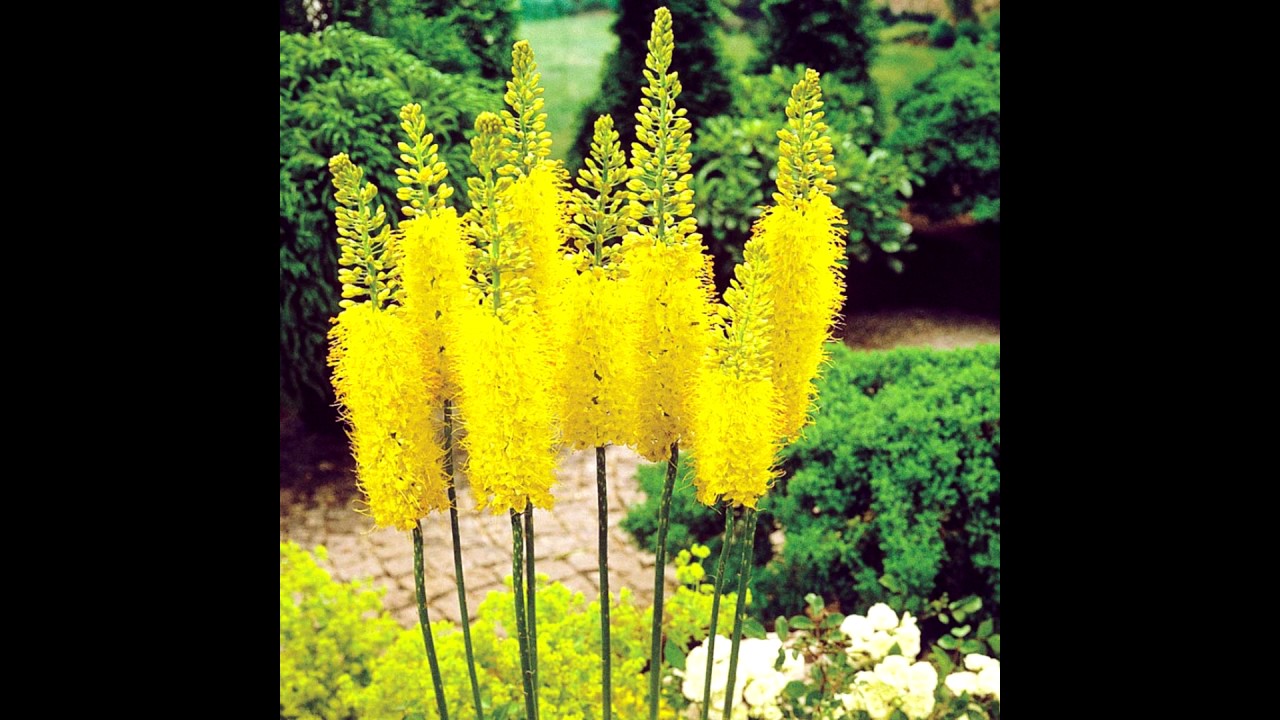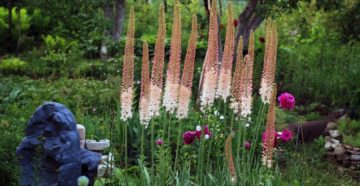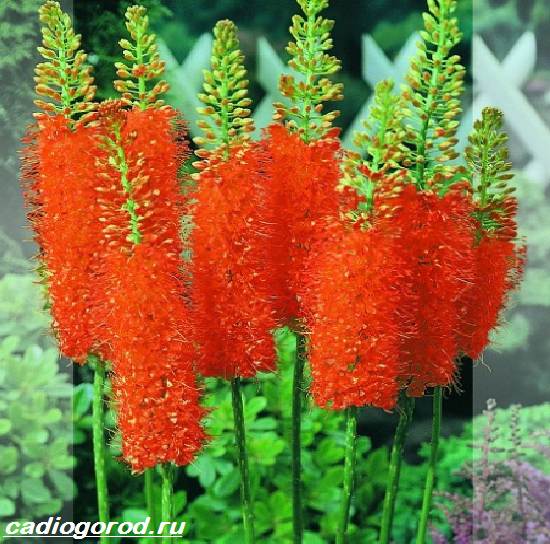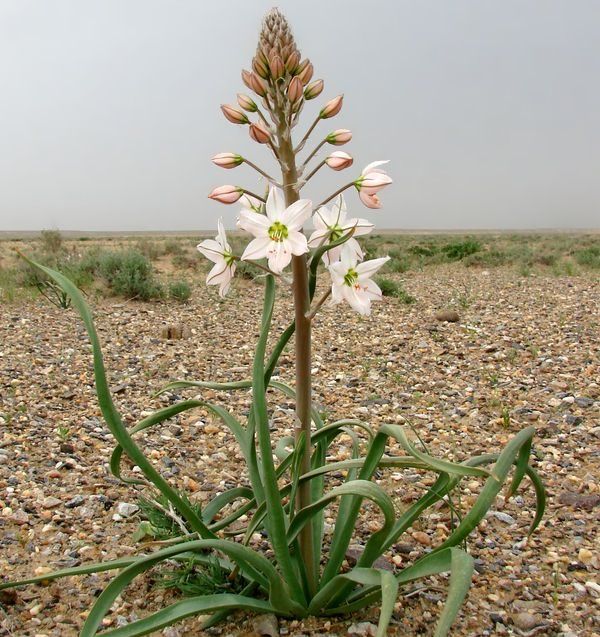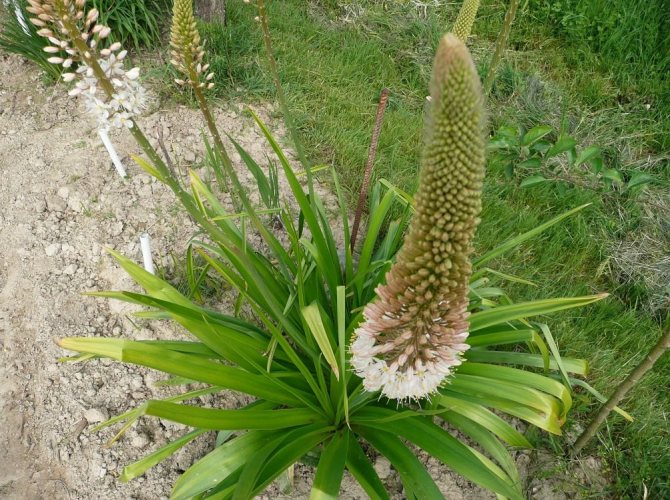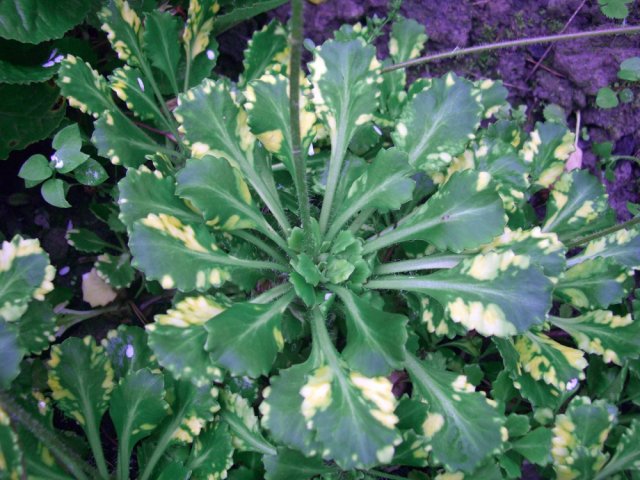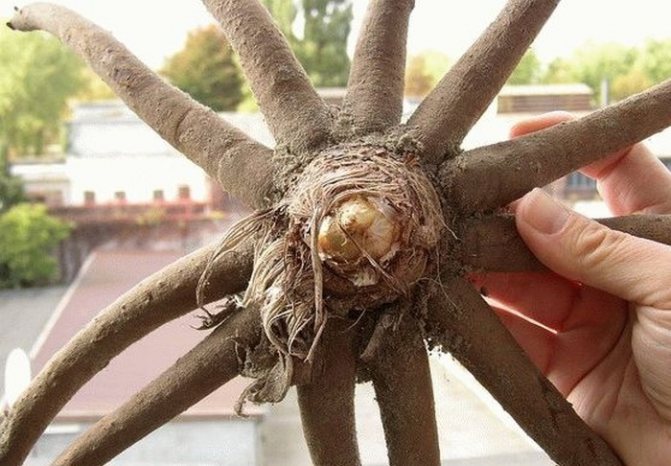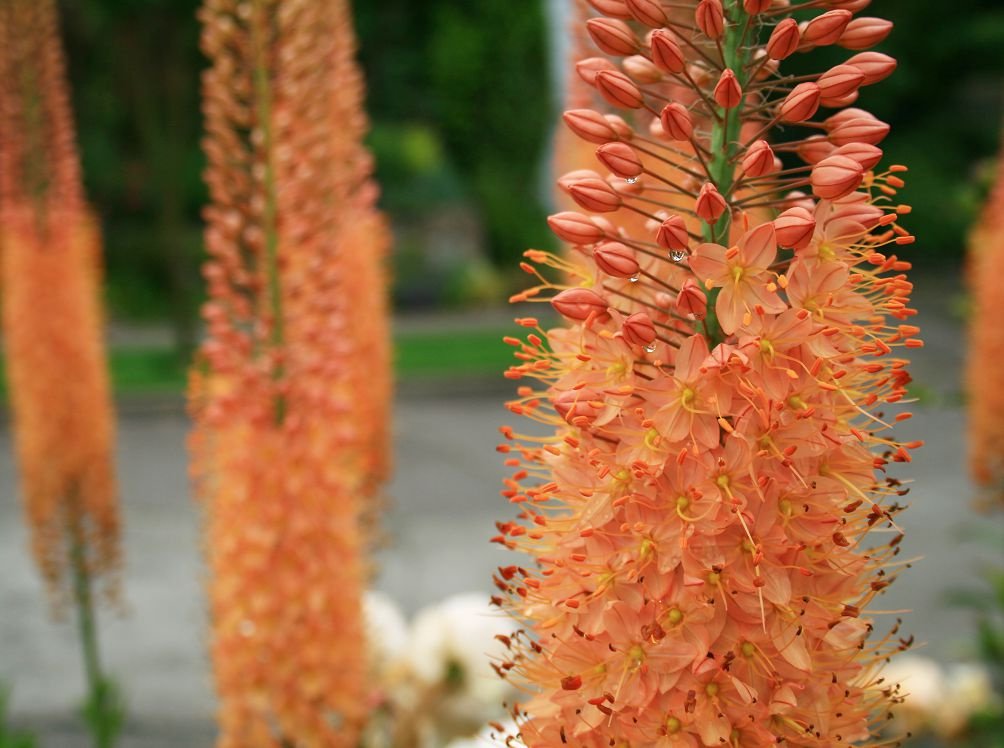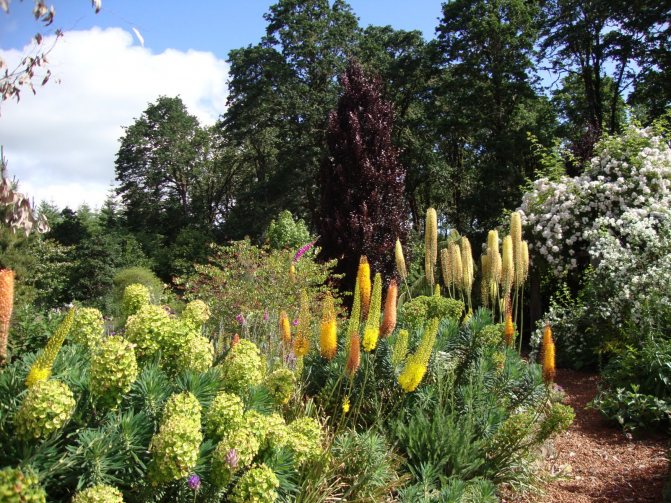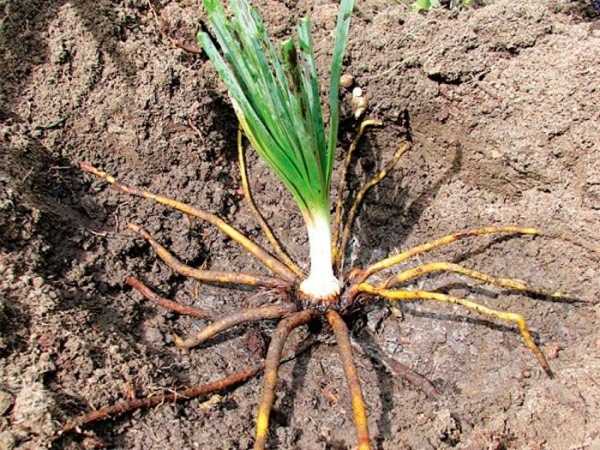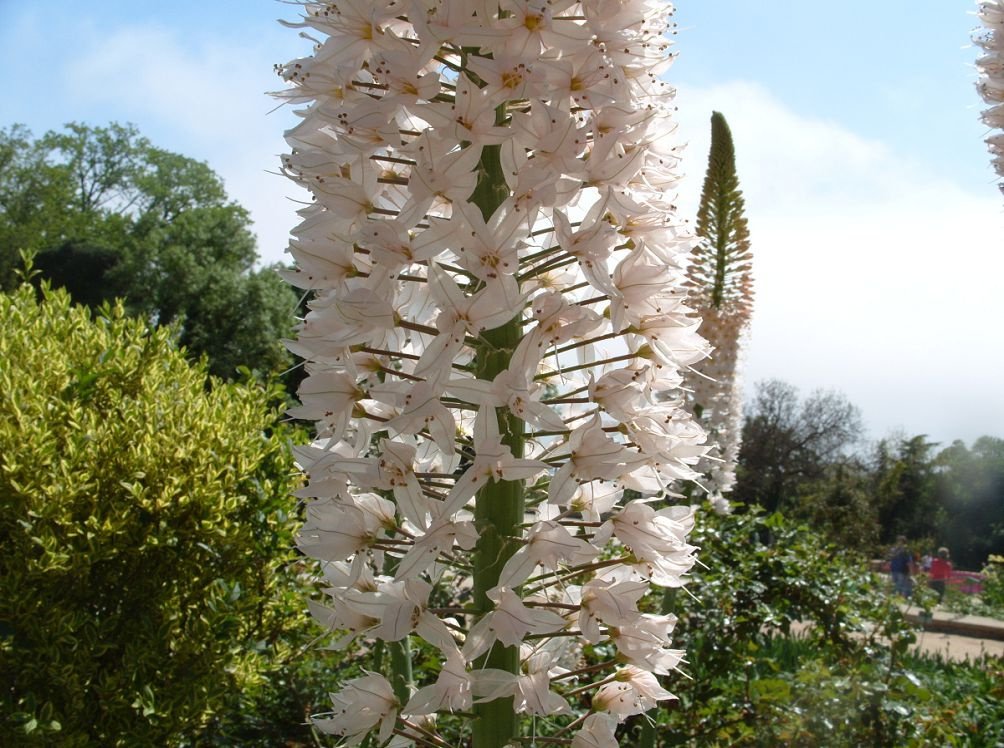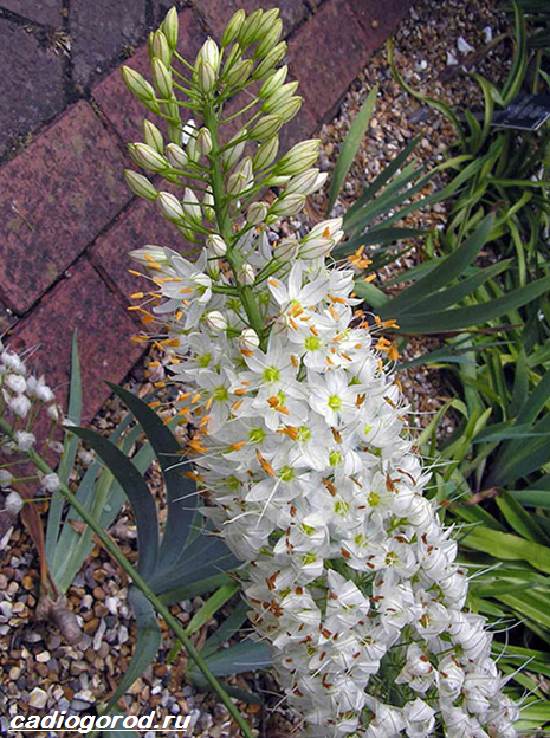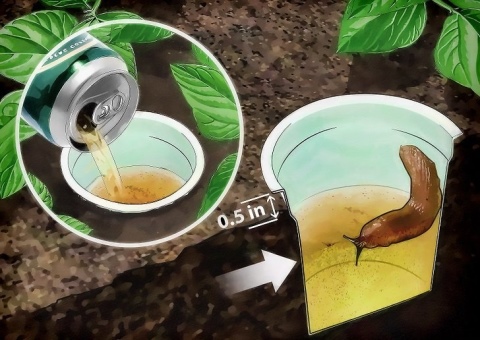Reproduction of eremurus
This perennial is considered difficult to reproduce, and this is often the reason for the very high cost of planting material, but in fact, shiryashi are not at all capricious in terms of reproduction of culture. Eremurus can be independently obtained from seeds or by vegetative methods.
The easiest way is to separate the adult Eremurus. Near the main rosettes of the plant, small rosettes constantly appear (usually from one to 3 annually), which signals the division of the Cornedonian and the formation of daughter ones, which have their own bottoms and roots of the buds. In the absence of division for many years, the plants thicken and bloom worse, but daughter plants should not be separated annually. Usually, the ability to separate new eremurus from the mother bush is checked by whether the connection lines break (if light pressure does not lead to separation, then it is not worth separating the babies for at least another year).
The separation and rejuvenation procedure is recommended to be carried out with a minimum frequency of 5-7 years, because otherwise the eremurus become smaller and grow over. With good conditions and care, division can be carried out much more often. The plots are carefully separated, the sections are processed and dried, if desired, they are etched with a solution of fungicides. Delenki are planted shallowly, in shallow planting pits about 10 cm deep.
An alternative method of vegetative propagation is to stimulate the separation of the Cornedonian by cutting. In strong and adult Eremurus, the bottom of the Cornedonian is slightly incised and incised, as if "marking" parts with several roots in each. After the cuts are treated with charcoal and dried, the plant is planted in a permanent place. By the next year, each "artificial division" forms its roots and buds, then the plants can be divided and transplanted, and in the second or third year the eremurus will bloom fully.
The seed reproduction method is quite simple, the plants bear fruit abundantly, but due to cross-pollination it is very difficult to predict the characteristics of the offspring. When self-collecting seeds, they are collected only from the lower part of the inflorescences, previously reducing the cylinders by one third to improve the seed formation process. For Eremurus, they do not winter, but autumn, September or October sowing of seeds. Sowing is best done in greenhouses or boxes rather than open beds. Seeds are sown in grooves about 1 cm deep. Eremurus do not germinate at the same time - some for the next year, and some of the seeds - after two or three years.
In the spring, seedlings develop quickly enough, they are grown, providing regular care, stable light moisture, protection from weeds and soil compaction. They continue to grow in boxes until the leaves wither, after which they are carried away to a dark and dry room without digging. In the fall, crops are placed in the garden, in the first winter they are covered with a high layer of mulch made from compost, leaves and spruce branches. Plants are grown in boxes until the third year, when the Cornedonian can be planted in open ground. Eremurus obtained from seeds will be able to bloom in regions with severe winters only 5-7 years after sowing.
Eremurus: planting and care
When growing, it should be remembered that in nature this plant grows in the steppe, in open spaces flooded with sunlight. The nature of the steppe rarely pampers vegetation with rains, so the Eremurus does not like waterlogging and will certainly die if, after the rain, it stands for a long time in a puddle of water, despite the fact that the rhizome of the Eremurus resembles an octopus.
 Eremurus rhizome resembles an octopus.
Eremurus rhizome resembles an octopus.
Indeed, the root system of the plant is located close to the surface.The upper part of the root of the eremurus is covered with buds, and the lower part dies off annually in order to regrow in the spring. For fear of damping out, the rhizome of the eremurus must be dug out for the winter like the tubers and bulbs of more familiar plants.
After flowering in June-July, the eremurus enters the summer dormancy period: the leaves dry up and the seeds ripen completely. It is during the summer dormancy period, from late July to late August, that the eremurus can die from excessive moisture. The reason may be heavy rains at the end of summer, which is why you can find recommendations for the construction of sheds and gazebos over the places where eremurus grow during the summer rest.
Of course, the most reliable way is to dig up the rhizomes in late July - early August, and store them in a dark place like tulip bulbs. Eremurus roots can be dug up when the leaves are dry, but no later than mid-August.
From the above, it follows that Eremurus should be planted in a sunny place where there is no stagnation of moisture even after heavy rainfall. It is best to plant the Eremurus on a high ridge so that excess water flows down freely. The bottom layer of the ridges can be made of fine gravel or pebbles and made so that the thickness of the soil above the drain is at least 30 cm.
Eremurus do not grow on heavy soil, so if the soil in your area is clay, you should improve it in any way possible. When preparing the soil, you should avoid preparing a soil mixture with an acid reaction - the optimal acidity of the soil for the eremurus pH Acidic soil should be improved with lime or dolomite flour.
The plant does not like stagnant moisture, but it will not refuse abundant watering in dry weather. Water it with heated water. If the soil on the site is poor, then before flowering, you can add a little sodium nitrate to the water, at the rate of 1 tsp. by 1 m 2.
Eremurus responds well to potash fertilization. In the spring, it is worth feeding the plant with potassium sulfate.
When feeding eremurus, it should be remembered that an excess of nitrogen fertilizers and organic matter (manure) impairs the plant's immunity, reduces disease resistance and impairs winter hardiness.
Most often, slugs damage the eremurus.
Reproduction methods
Seeds
Seeds must be used exclusively fresh. For a start, they are stratified in dry sand, keeping it in a cold place throughout the winter. When spring comes, they are placed in containers with special soil, which can be enriched with stimulants. In the fall, those sprouts that are the strongest should be left to winter in the same container. The room temperature should be cool, but above freezing. Then, after winter, the shoots are moved to separate containers. When they reach 0.3 meters in height, they can be safely transplanted into open soil or any other container.
Cuttings
The essence of this procedure is to use cuttings that are cut from the parent specimen. It is held in early autumn. The cuttings should be approximately 0.25 meters long. On each of them you need to have 2 sheets, which are cut in half. Before proceeding to planting, the cuttings are kept in a stimulating apparatus.
The resulting material is placed 5 centimeters into a well-loosened soil. In advance, the planting hole should be fertilized with mineral agents and provided with a drainage system. The ground should be light and relatively moist.
Planting and transplanting eremurus
The rhizomes of eremurus bought in the store are planted with the onset of autumn (in September), to a depth of 10 cm, keeping the distance between neighboring plants about 80 cm.It is advisable to pour a layer of sand into the hole before planting the rhizomes, and on top of a layer of mature compost.
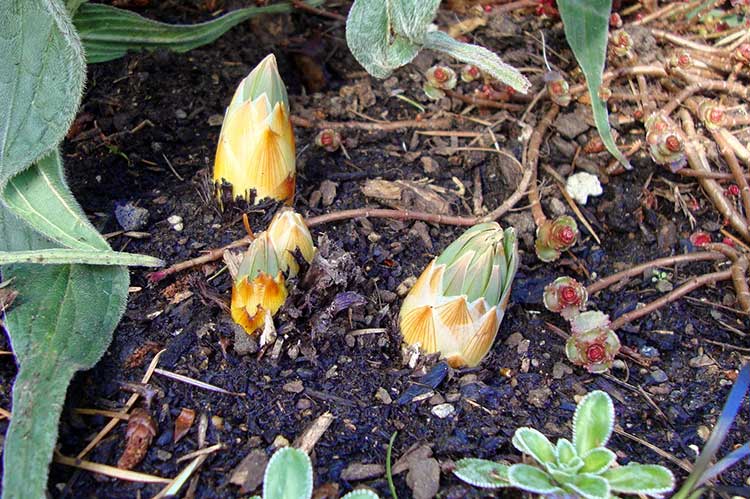 Eremurus woke up in the spring and started to grow. Photo: dangergarden.blogspot.co.uk
Eremurus woke up in the spring and started to grow. Photo: dangergarden.blogspot.co.uk
Immediately after planting, the soil surface must be mulched with peat or sawdust so that the roots successfully overwinter, but do not come out.In the spring, immediately after the arrival of heat, the roots will begin to grow, which is why Eremurus must be protected from spring frosts.
Frosts severely damage the leaves and inflorescences of eremurus, therefore, plants should be protected from spring weather in any way possible: by covering with a film, spruce branches, non-woven material, etc.
Do not often transplant Eremurus from place to place. The optimal transplantation time is once every 7-8 years.
Reproduction of eremurus
There are two ways to breed an Eremurus. We wrote about the seed method above, the second method is vegetative reproduction. Such reproduction can be carried out when a daughter sprout appears near the main trunk. It has its own root system and can be separated from the mother. After separation, treat the wounds on both roots with ash or crushed activated carbon, dry and transplant to a separate place
It is important that the "kids" are separated easily, without any effort. If this does not happen, let it ripen for another year.
An adult plant can be divided no more than once every 5 years.
Selection of partners for eremurus
Eremurus is a plant original enough to stand out favorably against the background of any decorative partner. Therefore, the choice of neighboring crops for Cleopatra's needle is limited only by practical tasks and the style of the garden. Since the eremurus completely or almost completely leaves the garden scene in the summer, it is necessary for it to select partners who can mask the glades, voids, and drying out leaves. Usually, Eremurus are combined with perennial stars, which come to the fore only at the beginning of summer. These perennials include veronica, monarda, garden geraniums, sage, daylilies, coreopsis.
When looking for plants that complement and set off the beauty of the Eremurus themselves, the choice is always made from the most spectacular bulbous, tuberous and textured stars. Eremurus go well with high and medium ornamental grasses, look harmoniously in addition to irises and yucca, echoing with them by the type of foliage and contrasting with their inflorescences. Daffodils will also be good partners for Eremurus, late varieties of tulips, hazel grouses, decorative bows, especially large species
Of the flowering neighbors, you should also pay attention to roses and herbaceous peonies with early flowering periods, penstemones, delphiniums, astrantia, solidago
If eremurus are dug, then the voids are usually filled with letniks, who are selected for the style and thematic design of the composition - vervains, calendula, purslane, etc.
Caring for eremurus in the garden
Planting eremurus in open ground has nuances, but care is very simple - it almost does not go beyond the usual garden procedures. Important points:
- regular watering;
- four dressings. Superphosphate in the fall - 40 g per 1 sq. m., in March, a complex mineral fertilizer of 60 g, or 6 kg of compost per 1 sq. m. During the growing season, two more top dressing - in May and before flowering, you can take a standard complex mineral fertilizer;
- weeding and loosening - neat so as not to hurt the tubers;
- removal of yellow and wilted leaves.
How to water a plant
Flower Adonis - planting and care in the open field
Watering needs careful and flexible watering.
The plant does not like excess moisture, but it needs an abundant amount of it to build up the mass of flowers, leaves, and the underground part. In a dry summer, in the first half of it, water is abundantly watered 1-2 times a week to ensure that the soil is soaked by 20 cm. In a rainy summer, watering is stopped. If there is rain at least once every seven days, watering is also excluded. After flowering, stop watering.
Important! The basic rule is to water abundantly before flowering, and then do not water. Eremurus Korolkova in vivo

Eremurus Korolkova in vivo
Reproduction of eremurus
The best way to reproduce eremurus is seed. Plants will be adapted to the specific site.But the method has drawbacks - it takes too long to wait for adult specimens, so they often resort to dividing the root.
The period of the procedure is the end of August, when the aerial part has completely died out, but the plant has not yet retired. The rhizome is opened, removing the top layer of soil above it, cut according to the number of living buds, usually 4 parts, abundantly sprinkle the wounds with crushed activated carbon, then again cover with soil. In the spring, each part will give its escape. It is necessary to let them grow, and by the end of summer, when they begin to die off, the individual nodules obtained can be planted.
Fact! Daughter rosettes are propagated much less often, they appear near the rhizome no more than 1 time in five years.
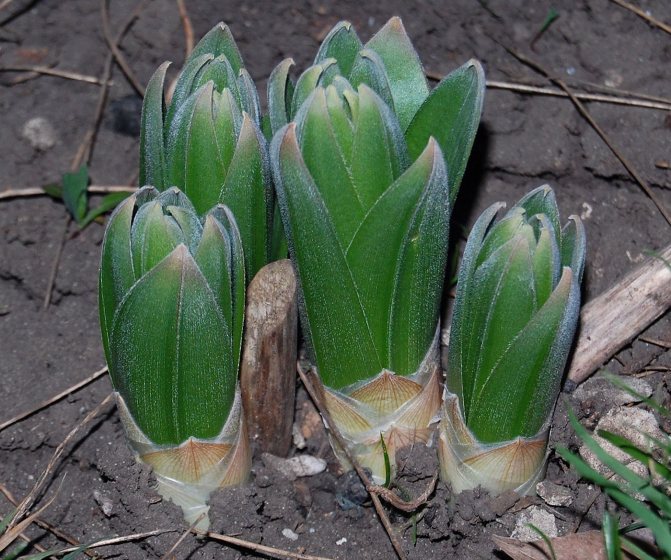
Eremurus powerful grows back after a period of rest
Diseases and pests
Aliens from other regions, especially those with a contrasting climate compared to the Middle Lane, often suffer from diseases. Eremurus, planting and caring for which is otherwise not difficult, is no exception. The plant can be affected by: rust, chlorosis, viral diseases. Eremurus like slugs and snails, and mice and moles willingly eat the underground part.
Most of these problems can be avoided by carefully dosing watering / feeding and arranging high-quality drainage. Disease attacks crops in damp, cold summers.
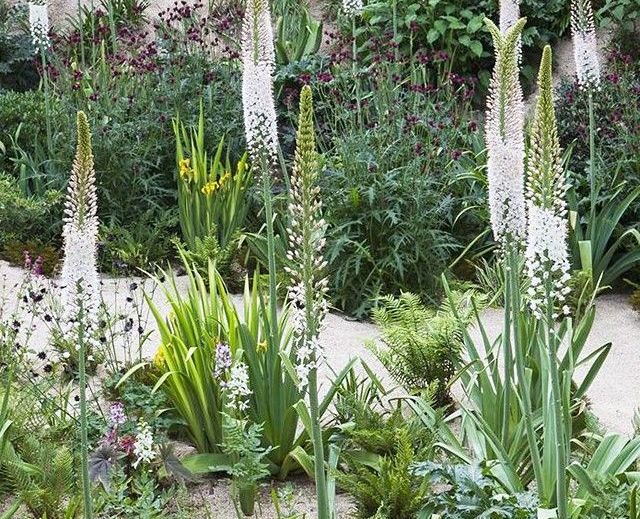
Eremurus along the path
Blooming care
Before flowering, they are watered with nitrogenous fertilizer - 20 g of ammonium sulfate per 1 sq. m., or complex, containing potassium, phosphorus and nitrogen in equal proportions. During the flowering period, watering is reduced, dried leaves are regularly removed, and the flower stalks themselves, if there is no seed collection in the plans.
Eremurus (eremurus) - description, photo
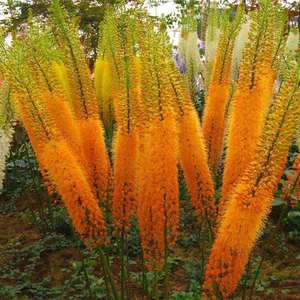
numerous bell-shaped flowers of brown, pink, yellow, dusty red or white
The root system of a perennial plant consists of a disc-shaped Cornedonian and fleshy roots extending from it. Narrow or wide, flat, trihedral-linear leaves are keeled on the underside.
The flowering period of the shiryash depends on the climate of the region where it grows. Flowers can begin to bloom as early as May or only in summer. First of all, the lower buds bloom on the brushes. Each flower blooms for no more than a day, but since there are many of them on the inflorescence, the eremurus bloom lasts from ten to forty days. By autumn, three-celled, almost spherical, wrinkled or smooth fruits are formed on the perennial. Triangular wrinkled seeds have a transparent wing.



